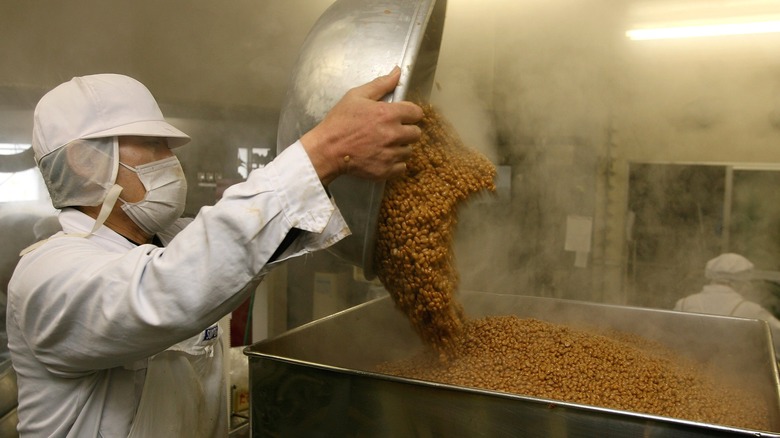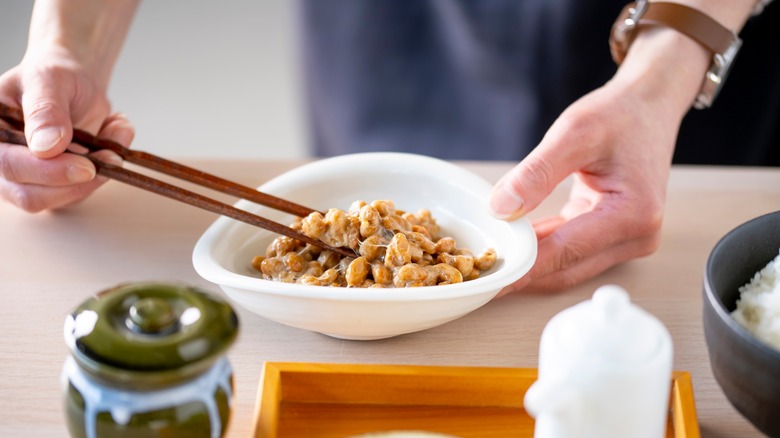Natto: The Fermented Bean Dish You Should Try At Least Once
Soybean products are found in many forms — be it tofu, soy milk, soy sauce, edamame, to miso paste. Few are as funky as natto, a delicious Japanese fermented soybean dish. Made with only soybeans and a special type of bacteria, natto ferments into a substance with savory, nutty, and satisfying flavor. The texture may be surprising to first-time eaters — it has a sticky web-like quality that meshes together. And after opening, it develops a characteristic smell similar to blue cheese.
Filled with protein, calcium, and other nutritional benefits, natto is an esteemed daily breakfast dish in Japan. Served with rice and a simple sauce, it's easy to see its appeal — it's a delicious and complex meal with only a few components. Plus, it's surprisingly malleable, perfect for adding a touch of umami to a variety of other flavors. Let's dive into what this palatable probiotic is all about.
History of natto
Natto's exact invention is unknown, although it's clear the dish has long been ingrained into Japanese cuisine. Scholars estimate the food may have originated 1,300 years ago in soybean-growing regions of Japan, or it may have been introduced from China. Most likely, it was an accidental discovery when soybeans were stored in the same container as rice since the grain contains the bacteria necessary for natto's fermentation.
An especially popular legend accredits renowned samurai Lord Minamoto no Yoshīe with inventing the dish during a war. In the story, the samurai and his legion were resting in a farmhouse, cooking a dinner of rice and soybeans. An imminent attack didn't allow them to finish their meal, so they combined the two components in rice straw baskets and strung them onto horses. The bacteria in the rice initiated fermentation, kickstarted by the horses' body warmth — and so natto emerged.
By the 17th century, natto expanded to be an everyday staple for much of the Japanese population. Eaten both as street food and in the home, it became especially popular in Northern and Eastern Japan. Today, it continues to be strongly affiliated with these outlying regions.
How natto is prepared
Natto is created from only soybeans, water, and bacteria, relying on fermentation to transform a single ingredient into a tasty dish. Many types of soybeans are utilized for natto, ranging from yellow to black varieties. Smaller seeds are favored since they'll ferment more uniformly, producing a better flavor and sticky texture.
After the soybeans are sorted and washed, they're soaked in water for up to 18 hours. Such a process expands their size and sets up the soybeans for a more even cooking process. Next, the beans can either be boiled or steamed, with the latter method preferred to retain the soy's consistency. Steaming also disinfects the beans, ensuring fermentation takes place smoothly.
While the soybeans are still hot, a bacteria known as Bacillus subtilis is introduced to the mix. The organism is sometimes incorrectly referred to as yeast since it's a rare type of bacteria that forms spores. It's essential that the soybeans are hot during this infusion — the spores propagate at conditions other bacteria don't, ensuring an even fermentation.
After up to 24 hours of fermentation, natto is transferred to a fridge. While the bacteria activity slows, biological processes continue, enriching the natto's flavor. Aging times, as well as the precise strain of bacteria, vary based on the producer — all contributing to unique natto profiles.
How natto is served
In Japan, natto is mixed together with rice and consumed as breakfast. Typically, store-bought natto comes with flavor packets of dashi, a savory seafood broth, and karashi, a spicy Japanese mustard. Some diners also add soy sauce, and toppings like green onions, nori, poached eggs, and pickles.
It's rare for this dish, called Natto Gohan, to appear on menus in Japan — it's a simple creation usually enjoyed at home. Instead, the fermented beans are only found in eateries as a topping into bento bowls, alongside ingredients like seafood, yam, eggs, seaweed, and more.
Past traditional consumption, natto is a highly versatile food that melds well in a variety of applications. It can be a funky topping for avocado toast or a delicious filler for an omelet. Some toss a bit into miso soup, and others top tofu with natto for a soybean-heavy meal. Its umami-rich flavor also combines well with grilled fish, especially salmon.
Health benefits of natto
Natto contains many nutritional qualities beneficial to health. Most notably, it contains nattokinase, a type of enzyme that reduces clotting and significantly improves cardiovascular health, according to the U.S. National Library of Medicine. Additionally, natto creates dipicolinic acid during fermentation. This compound is sometimes even used as a medicine for its potent antibacterial qualities, per Science Direct.
Like other fermented foods, natto has probiotic qualities. The bacteria used for its fermentation, Bacillus subtilis, is also found naturally in the gastrointestinal tract. This bacteria produces K2, a vitamin that has shown positive effects on cardiovascular and bone health. Vitamin K2 is also found in other cured foods like cheese and cured meats.
And like milk products, natto contains a substantial dose of calcium, with a serving of 100 grams giving you 17% of the daily requirement. Calcium contributes to bone health, functioning in combination with vitamin K, notes Healthline. And to round out its qualities, natto is an excellent protein source, especially for vegetarians, per the NLM. Such helpful qualities have led to natto's reputation as a healthy daily food in Japan.
Where to find natto
Natto is ubiquitous in Japan and sold widely in grocery stores. It'a available in many forms, with many soybean varieties, salted and unsalted types, as well as a chopped version. In the U.S., there's not quite as broad of a selection, although the food is quickly increasing in popularity. Recently, major retailers like Walmart, Target, and Kroger started carrying natto. Additionally, it can be purchased online, and found in Asian groceries. It's typically stored in the refrigerator or freezer, alongside other soy products.
For those interested in fermentation, natto can also be made at home. Soybeans are easy to find, but the bacterial spores are a little more difficult — look for starter cultures online.
Once natto is purchased or produced, it has a short shelf life of only a few days. Consider freezing to improve its sturdiness — in such a form, it'll store for a month. Additionally, make sure to finish the package soon after opening, or else the fermentation will restart and lead to even quicker spoilage. For this reason, natto is often sold in single-serve packages.





